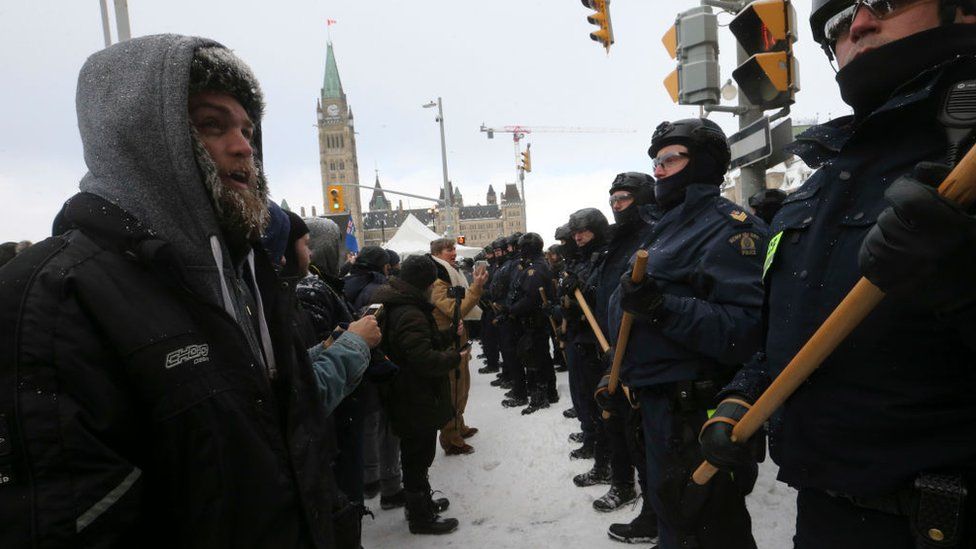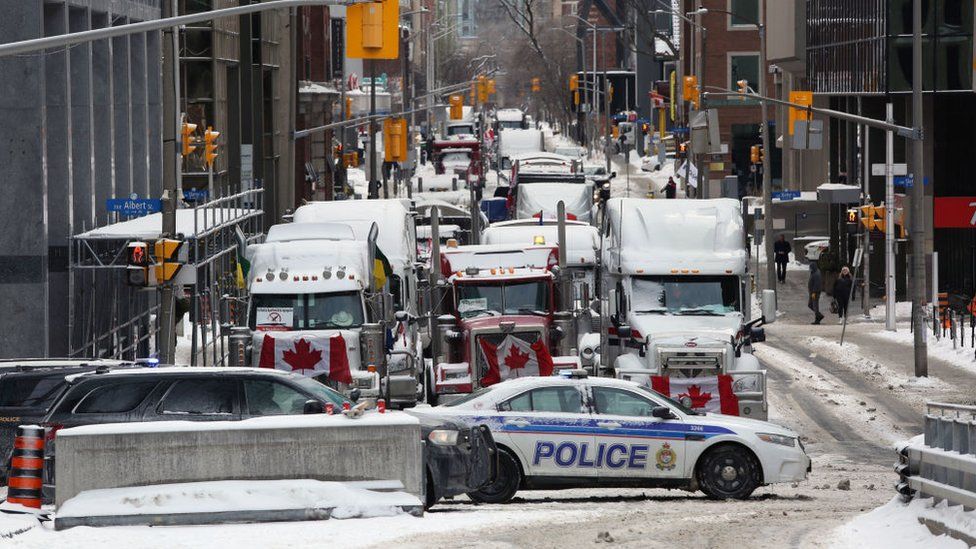Freedom Convoy: Trudeau to testify at Emergencies Act inquiry
Emergencies Act #EmergenciesAct

Last February, Prime Minister Justin Trudeau invoked never-before-used emergency powers to bring an end to the “Freedom Convoy” protest that had gridlocked Canada’s national capital for three weeks and gained international attention.
Now a public inquiry into Mr Trudeau’s unprecedented use of the federal Emergencies Act to end the protests against vaccine mandates and Covid measures begins in Ottawa, with an extensive witness list that includes the prime minister himself as well as convoy organisers.
The act, in place between 14 February and 23 February, allowed the government to impose bans on public assembly in some areas and to prohibit travel to protest zones, including by foreign nationals, among other measures. It also gave authorities the ability to freeze bank accounts.
Here is what you need to know about the Public Order Emergency Commission and the public hearings.
What do I need to know about the inquiry?
The Public Order Emergency Commission began six weeks of hearings on Thursday that would examine the Trudeau government’s decision to declare a public order emergency, the circumstances that led to that declaration, and the measures put in place by Ottawa to clear the protests.
It has also been tasked by the federal government to look into the “evolution and goals” of the convoy and the impact of domestic and foreign funding and disinformation. The economic impact of the protest and the work of police will also be in the spotlight.
Hearings will last until 25 November and will be headed by Justice Paul Rouleau, of the Court of Appeal for Ontario.
The 1988 Emergencies Act requires that a formal inquiry be held after the act is invoked – and the commission must also release a final report on its findings to parliament by early next year.

Image source, Toronto Star via Getty Images
Mr Rouleau opened the hearings warning of the tight timeline for its work and a vow to “actively control” the proceedings, cautioning it should not become “adversarial”.
“I recognise different points of view will be forcefully advanced,” he said.
He underscored the importance of addressing the complex issues and “matters of fundamental importance” at hand, noting it will mark the first time the powerful legislation will be reviewed in the 34 years since it was adopted into law.
Separately, a joint parliamentary committee has also been holding hearings into the use of the act.
Who are the witnesses?
The most anticipated witness is likely Mr Trudeau, who is scheduled to appear at a still undetermined time.
Asked about the coming inquiry on Wednesday, the prime minister said he felt it necessary at the time to move “forward with measures not to be taken lightly” and noted the process includes ensuring accountability for their use after the fact.
“I look forward to the work the commission is going to do and I know a lot of questions Canadians have will be answered,” he said at a media event.
All told, some 65 people are expected to make an appearance in the coming weeks, with the first of them appearing on Friday.
Also on the witness list are high-ranking members of Mr Trudeau’s cabinet, including Deputy Prime Minister Chrystia Freeland and Emergency Preparedness Minister Bill Blair; senior members of the Royal Canadian Mounted Police; current and past members of the Ottawa police force; and Canadian intelligence officials.
Convoy organisers Chris Barber and Tamara Lich – who are both facing charges including mischief and obstructing police linked to February’s protests – are scheduled to appear.
Further, Mr Rouleau has granted either full or partial standing to 39 individuals and entities, meaning they have an opportunity to participate directly in the proceedings. Standing privileges range from getting advance notice of documents to the ability to cross-examining witnesses.
Among those that have received full standing are the federal government, the provinces of Alberta and Saskatchewan, the Ottawa Police Service, and Ms Lich and Mr Barber.
The Canadian Civil Liberties Association (CCLA), which has challenged the use of the Emergencies Act in court, was also granted standing.
“The protests needed to be addressed but the government also had an obligation to comply with the law and use emergency powers as a truly last resort,” said the CCLA’s Cara Zwibel on Wednesday.
“That is not the case and it is our opinion that their actions were unlawful and unconstitutional.”
She said they would use their standing to “vigorously test” the government’s evidence.
The government has also agreed to release cabinet documents related to discussions about the use of the act to the commission.
What happened during the ‘Freedom Convoy’ protests?
The protest began in January to oppose a vaccine mandate for truckers crossing the US-Canada border, and grew into a broader opposition to pandemic restrictions and Mr Trudeau’s government generally, with supporting protests across the country.
After a week-long drive across Canada, a few hundred big rig trucks arrived in Ottawa, gridlocking the city centre in front of parliament.

Image source, AFP via Getty Images
They were joined on the weekends by thousands of protesters – angry over two years of pandemic restrictions.
Online fundraisers pulled in millions of dollars for the convoy.
Many businesses felt forced to shut their doors during the protest and Ottawa residents complained of harassment and constant noise, though the protest site occasionally had a party-like atmosphere.
Other, shorter lived protests cropped up at two key border crossings, near Coutts, Alberta and at the Ambassador Bridge, a vital trade route between the US and Canada. Police cleared both those protests before Mr Trudeau invoked the public order emergency.
The demonstration was quickly deemed by the federal government and police as an illegal blockade, and in mid-February, the province of Ontario declared a state of emergency.
Police and tow trucks eventually cleared the protest site in Ottawa over the weekend of 18 February.